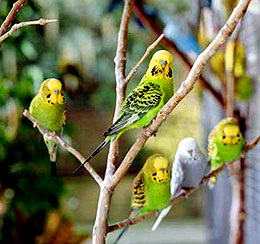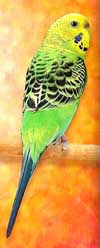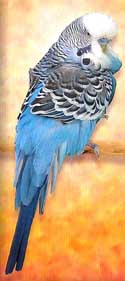Breeding Budgerigars
Budgerigars have been successfully bred in captivity since they were first domesticated in 1840. They are the easiest members of the parrot family to breed and a large number of color mutations and variations have arisen from captive breeding of these birds. Budgerigars can be bred in separate cages but may also be bred out in an aviary, as they are highly sociable birds and breed in colonies in the wild.

Sexing
The two sexes are easily identified by the color of the cere, which is the fleshy area above the beak, containing the nostrils. Adult females have a brown cere which deepens in color when the female is in good breeding condition. Females also become destructive when they are in breeding condition, and will tear up tray liners and gnaw at perches. In contrast, adult males have a blue or purple cere. It is difficult to tell the sex of young budgerigars from the color of their ceres, and it is recommended that birds under 10 months old are not used for breeding.

Female Budgie

Male Budgie
Timing
Spring is the best time of the year to breed budgerigars. Although it is possible to breed these birds at other times of year, it is recommended that nest boxes are only introduced during the spring, as the birds will be in peak breeding condition and the best results from breeding attempts are seen at this time of year.
Nesting
Budgerigars are commonly bred in boxes which open at one end, and a variety of designs are available. The interior of the nest box should be lined with a wooden or plastic nest pan, which consists of a flat piece of wood with a depression hollowed out at one end for the eggs to be laid in. No additional nesting materials need to be supplied.
Egg Laying
Budgerigars typically lay a clutch of four to six eggs, although the clutch size can range from one to eight. The eggs are laid on alternate days and the incubation period is 18 days.
Diet
Calcium is very important for the production of egg shells and Cuttlefish bone and grit are both important calcium sources for laying hen birds. Soft foods or soaked seed are also useful supplements during the breeding period.
Care of the young
Budgerigar chicks are born blind and without feathers. They are totally dependent upon their parents for food whilst they are in the nest, and remain in the nest box for up to 24 days. The chicks will begin to learn to feed themselves once they leave the nest. They are fully independent, and able to be removed from their parents at around 32 days old.
[ Search Articles ] [ Article Index ]
